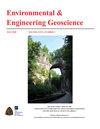Using Reference Springs to Describe Expected Flow, Temperature, and Chemistry Conditions for Geologically Related Groups of Springs
IF 0.7
4区 工程技术
Q4 ENGINEERING, ENVIRONMENTAL
引用次数: 4
Abstract
Reference springs can result in improved conceptual models of groundwater flow and an expanded understanding of the temporal variations in flow, temperature, and chemistry that may be expected for related springs. The reference spring concept is patterned off of the common practice of establishing reference sites to establish benchmark ecological conditions. We use the term “reference spring” to indicate a spring that is minimally disturbed and representative of a geologically related group of springs. Seven reference springs were selected from six previously defined groups that represent over 400 springs in Wisconsin, United States. Geologic cross-sections were constructed for each reference spring site, and springs were monitored for flow, spring-water temperature, and chemistry for up to 4 years, revealing new relationships within and between groups. Examples include: a range of temperature conditions that can be related to the depth of groundwater circulation for springs discharging from layered bedrock uplands, and differences in thermal patterns and specific conductance that can be related to the permeability and solubility of surficial glacial deposits for springs emanating from uneven glacial terrain. The results suggest that establishing reference springs may be a useful approach in other regions where geologically related groups of spring have been identified.使用参考泉水来描述与地质相关的泉水群的预期流量、温度和化学条件
参考泉水可以改进地下水流动的概念模型,并扩大对相关泉水的流量、温度和化学的时间变化的理解。参考春天的概念是基于建立参考地点以建立基准生态条件的常见做法。我们使用“参考弹簧”一词来表示受干扰最小的弹簧,并代表地质上相关的弹簧组。七个参考弹簧是从六个先前定义的组中选出的,这些组代表了美国威斯康星州的400多个弹簧。研究人员为每个参考泉水地点绘制了地质剖面,并对泉水进行了长达4年的流量、泉水温度和化学成分监测,揭示了群体内部和群体之间的新关系。例子包括:与从分层基岩高地流出的泉水的地下水循环深度有关的一系列温度条件,以及与来自不均匀冰川地形的泉水的表面冰川沉积物的渗透性和溶解度有关的热模式和特定电导的差异。结果表明,建立参考弹簧可能是一种有用的方法,在其他地区的地质相关群的弹簧已经确定。
本文章由计算机程序翻译,如有差异,请以英文原文为准。
求助全文
约1分钟内获得全文
求助全文
来源期刊

Environmental & Engineering Geoscience
地学-地球科学综合
CiteScore
2.10
自引率
0.00%
发文量
25
审稿时长
>12 weeks
期刊介绍:
The Environmental & Engineering Geoscience Journal publishes peer-reviewed manuscripts that address issues relating to the interaction of people with hydrologic and geologic systems. Theoretical and applied contributions are appropriate, and the primary criteria for acceptance are scientific and technical merit.
 求助内容:
求助内容: 应助结果提醒方式:
应助结果提醒方式:


